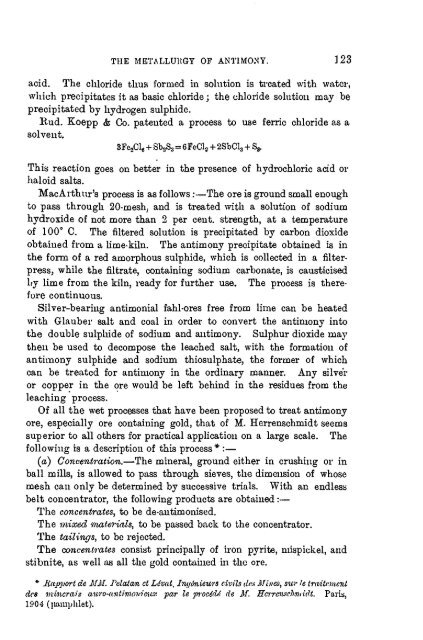antimony - Sciencemadness.org
antimony - Sciencemadness.org
antimony - Sciencemadness.org
You also want an ePaper? Increase the reach of your titles
YUMPU automatically turns print PDFs into web optimized ePapers that Google loves.
THE METALLURGY OF ANTIMONY. 123<br />
acid. The chloride thus formed in solution is treated with water,<br />
which precipitates it as basic chloride; the chloride solution may be<br />
precipitated by hydrogen sulphide.<br />
Rud. Koepp & Co. patented a process to use ferric chloride as a<br />
solvent.<br />
3Fe2Cl6 + Sb2S3= 6FeCl2 + 2SbCl3 + S3.<br />
This reaction goes on better in the presence of hydrochloric acid or<br />
haloid salts.<br />
MacArthur's process is as follows:—The ore is ground small enough<br />
to pass through 20-mesh, and is treated with a solution of sodium<br />
hydroxide of not more than 2 per cent, strength, at a temperature<br />
of 100° C. The filtered solution is precipitated by carbon dioxide<br />
obtained from a lime-kiln. The <strong>antimony</strong> precipitate obtained is in<br />
the form of a red amorphous sulphide, which is collected in a niterpress,<br />
while the nitrate, containing sodium carbonate, is causticised<br />
by lime from the kiln, ready for further use. The process is therefore<br />
continuous.<br />
Silver-bearing antimonial fahl-ores free from lime can be heated<br />
with Glauber salt and coal in order to convert the <strong>antimony</strong> into<br />
the double sulphide of sodium and <strong>antimony</strong>. Sulphur dioxide may<br />
then be used to decompose the leached salt, with the formation of<br />
<strong>antimony</strong> sulphide and sodium thiosulphate, the former of which<br />
can be treated for <strong>antimony</strong> in the ordinary manner. Any silver<br />
or copper in the ore would be left behind in the residues from the<br />
leaching process.<br />
Of all the wet processes that have been proposed to treat <strong>antimony</strong><br />
ore, especially ore containing gold, that of M. Herrenschmidt seems<br />
superior to all others for practical application on a large scale. The<br />
following is a description of this process * :—<br />
(a) Concentration.—The mineral, ground either in crushing or in<br />
ball mills, is allowed to pass through sieves, the dimension of whose<br />
mesh can only be determined by successive trials. With an endless<br />
belt concentrator, the following products are obtained:—<br />
The concentrates^ to be de-antimonised.<br />
The mixed materials, to be passed back to the concentrator.<br />
The tailing's, to be rejected.<br />
The concentrates consist principally of iron pyrite, mispickel, and<br />
stibnite, as well as all the gold contained in the ore.<br />
* Mapport de MM. Pelatan ct L4vat, Inydnieurs eivils drs Mines, sur le traiUmcnt<br />
de8 minerals auro-antimomeux par le procAdi de M. Hcrrcnschmidt. Paris,<br />
1904 (pamphlet).
















